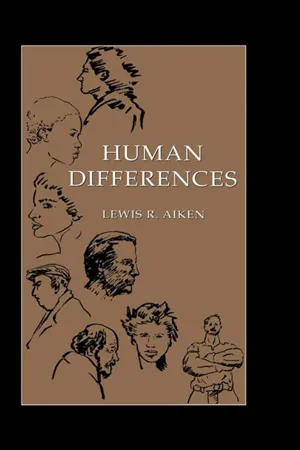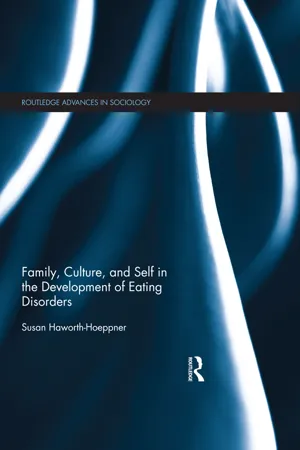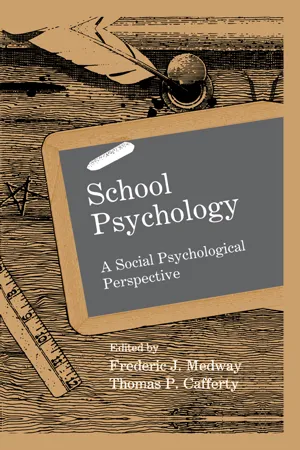Psychology
Physical Attractiveness
Physical attractiveness refers to the degree to which a person's physical features are deemed pleasing or appealing. It is often influenced by cultural and societal norms, and can impact social interactions, relationships, and self-esteem. Research in psychology has explored the factors that contribute to perceptions of physical attractiveness and its effects on individuals' behavior and well-being.
Written by Perlego with AI-assistance
Related key terms
Related key terms
1 of 4
Related key terms
1 of 3
10 Key excerpts on "Physical Attractiveness"
- eBook - ePub
All in the Mind
Psychology for the Curious
- Adrian Furnham, Dimitrios Tsivrikos(Authors)
- 2016(Publication Date)
- Wiley-Blackwell(Publisher)
beautiful is good bias. Research repeatedly demonstrates a positive correlation between Physical Attractiveness and treatment from others, leading physically attractive individuals to have better jobs, higher incomes, and more friends than others. Such studies leave us in no doubt that physical beauty can have a profound impact on an individual’s daily life. What such studies do not answer, however, is how we should define attractiveness. This is an important question, not least because it colors the way we examine the social impact of attractiveness, as well as questions concerning body image and body esteem.8.2 Defining Attractiveness
So how to define attractiveness? It used to be said of attractiveness, as a judge once said of pornography, that it is difficult to explain but easy to recognize. It comes as no surprise, therefore, to learn that human beings have been trying to do just that – explain beauty – for centuries. The ancient Greeks, for example, believed that beauty was a matter of having the right mathematical proportions. Indeed, mathematical functions of beauty, such as Plato’s golden section, also featured prominently in the notebooks of Leonardo da Vinci and other artists of the Renaissance.The idea that beauty is in the eye of the beholder – that different people have different ideas about beauty and therefore do not agree about who is, and who is not, beautiful – was for a long while the dominant view in much of philosophy and art.In contrast to the subjective view of beauty, however, psychologists have argued that there may be objectively defined criteria of attractiveness. Socialization theorists, for example, emphasize the effects on judgments of beauty of social and cultural norms, and stress the idea that social stereotypes such as the “attractiveness is good” bias create their own reality. A different idea that is currently very popular in both lay and scientific circles is that beauty is a reliable index of health and fertility. This is the evolutionary psychological - Adelina Broadbridge, Adelina Broadbridge(Authors)
- 2023(Publication Date)
- Emerald Publishing Limited(Publisher)
Confounds of attractiveness (race/ethnicity, sex and/or gender, age, changing beauty standards, etc.) are sometimes considered. Various perspectives are taken as well – most recently evolutionary arguments are common (e.g. Lee et al., 2015; Rhodes, 2006; Sugiyama, 2015). The evolutionary psychology perspective on attractiveness posits that attractiveness is used by others as an indicator of health and genetic compatibility. In this chapter, however, we frame the effects of attractiveness as power and status dynamics shaped by the context of the workplace. Attractiveness serves as a social status that mostly provides benefits in the workplace, although the results are not uniformly positive. We first explain attractiveness as a status characteristic and how it operates in general social interactions. We then examine these effects across three typical yet significant career development milestones in a worker's life: (1) the selection and hiring process of employment, (2) day-to-day interactions with colleagues and co-workers and (3) in leadership roles and positions. Attractiveness as a Status Characteristic Attractiveness plays an important role in day-to-day social interaction. We think that a useful way to envision this social dynamic is by thinking of Physical Attractiveness as a status characteristic. As such, attractiveness can be seen as carrying expectation states, as originally defined by Berger et al. in 1977 (Webster & Driskell, 1983). In their definition, a status characteristic is ‘any characteristic of actors around which evaluations of and beliefs about them come to be organised’, such as gender, race, age, attractiveness and education (Berger et al., 1980, p. 479). Ridgeway (1997) subsequently identified the concept of status beliefs, a set of ideas about competence that become associated with certain states of various characteristics, in this case, attractiveness- eBook - ePub
- Lewis R. Aiken(Author)
- 2014(Publication Date)
- Psychology Press(Publisher)
Appearance and behavior are easily obtainable types of information for evaluating people, at least superficially. With patience and perceptiveness, a better indication of the character and personality of the inner man or inner woman can be obtained, but most social encounters are fairly brief ones and provide little opportunity to figure out what a person is really like under his or her public persona. Nevertheless, first impressions are important in determining a person’s acceptability and attractiveness to other people—his or her social stimulus value. Because of its significance as a social variable and its relationship to success in many different arenas, a great deal of attention has been devoted by social psychologists and other behavioral scientists to the study of physical and behavioral attractiveness.Physical Attractiveness plays an important role in determining the self-concept —how a person feels about him or herself. According to Cooley’s (1922) looking-glass theory of the self, a person’s self-concept is the result of reflected appraisals. This implies that people come to see themselves according to their perceptions of how they are seen by other people. Consequently, most people do everything they can, within reason, to make positive impressions on others so they will be favorably evaluated and thereby feel good about themselves. They realize that in most interpersonal contexts—familial, educational, employment, recreational, and romantic—physical appearance is at least as important as ability and personality in determining acceptability and approval (e.g., Collins & Zebrowitz, 1995).Gender Similarities and DifferencesAppearance is quite important to most White females, but they are not the only ones who pay attention to their looks. Men, as well as women of other racial or ethnic groups, spend a substantial amount of time inspecting themselves in mirrors, grooming, and doing other things to make themselves more socially attractive. As seen in their preoccupation with their hair, skin, and other body parts, and with being taller and heavier, many more men than might be expected have body-image problems. - Susan Haworth-Hoeppner(Author)
- 2016(Publication Date)
- Routledge(Publisher)
1 The Cultural Milieu of Physical Attractiveness DOI: 10.4324/9781315639475-2For the past several decades social science research has been interested in the relationship between standards of attractiveness and body image. This is particularly true in research concerned with feminine standards of beauty and eating disorders. In our society there is considerable consensus about what it means to be attractive, and perhaps the most powerful aspect of Physical Attractiveness involves having a “fit” body which, for women, means a well-toned and slender shape and, for men, a strong and muscular one. Females strive for thinness, which they pursue through dieting and/or exercise, in hopes of becoming smaller.1 Males, on the other hand, consistently indicate that their main concern with their appearance does not lie in weight loss as much as it does in gaining muscle and building upper body strength.2 The difference: females in general3 desire to become thinner, to reduce their body size, whereas males aspire to become more muscular, and larger. While these bodily ideals indicate noteworthy distinctions, they share a common element, a focus on body size. But this emphasis, part of contemporary Western standards of attractiveness, is not a cultural universal, neither geographically nor historically.Cultural Variations in Attractiveness
What people have found aesthetically or erotically pleasing within various cultural contexts does not represent a universal standard. Ideals of beauty, handsomeness, or sexual attractiveness vary widely between one historical period and another; one culture and another; one nation and others.4 For instance, “The Venus of Willendorf,” a Paleolithic stone figurine that dates from before 25,000 b.c.e., represents a feminine form with pendulant breasts, a large abdomen and thighs, and ample hips. This statuette has been interpreted by scholars in a myriad of ways: as a symbol of fertility, an erotic fetish, or a pre-historical illustration of what moderns would call obesity.5 But the body has been more than variously represented and “read”: it has been manipulated as well, in order to suit notions of attractiveness that involve considerable alteration. More than 30 years ago, Susan Brownmiller described numerous, extreme beauty regimes practiced by or on females, citing the elongated necks of the Myanmar (progressively stacked neck rings achieve this extension); a three-inch foot for the Chinese (produced by foot binding); and small waist lines in the West (accomplished in the past by corseting and, contemporarily, by cosmetic surgery).6 Shaping of the head has been practiced in many cultures: pre-Neolithic Jericho, ancient Egypt, Greece, and Rome. Today, among the Mangbetu in Central Africa, infants’ heads are bound, using cloth and boards, to create elongated skulls.7 Bodily cicatrizing of adolescent and adult Kau, Nuba, and Dinka females in Sudan, head shaving and face painting of “brides to be” among the Maasai in Kenya—humanity has long practiced alteration and adornment to celebrate rites of passage or to effect beauty.8- eBook - ePub
- Thomas R. Alley(Author)
- 2013(Publication Date)
- Psychology Press(Publisher)
The greater psychosocial impact of Physical Attractiveness for females is probably responsible for sex differences in the correlations between Physical Attractiveness and psychological self-reports. For instance, Mathes and Kahn (1975) found significant correlations between independently rated Physical Attractiveness and self-rated happiness (r =.37), self-esteem (r =.24), and psychological health (neuroticism) (r = –.22) for female university students, but no significant correlations for males. Likewise, the greater importance of attractiveness for females may be reflected in psychophysiological measures. Among young adults, unattractive females have significantly higher average blood pressure than attractive females, even when controlling for obesity, whereas attractiveness and blood pressure are generally unrelated in males (Hansell, Sparacino, & Ronchi, 1982). Facial attractiveness can enhance or exaggerate perceptions of men’s masculinity and women’s femininity (Cash, 1981; Heilman & Saruwatari, 1979). Likewise, the favorable impact of facial attractiveness on performance evaluations of women can be modulated by task sex-typing, with attractiveness being less beneficial for “masculine” tasks (Cash & Trimer, 1984). Nonetheless, our culture and many others view Physical Attractiveness as a necessity for being fully feminine, but a man need not be handsome to be seen as masculine (cf. Adams & Crossman, 1978). “Good looks are prerequisite for femininity but incidental to masculinity” (Freedman, 1986, p. 2). In a survey of 28,000 readers of Psychology Today (who are typically better educated and more liberal than the average American), almost twice as many men as women viewed Physical Attractiveness as a “very important” or “essential” trait of an ideal member of the opposite sex (Tavris, 1977). In our society even the pursuit of beauty is considered an aspect of femininity - eBook - ePub
Social Psychology in Christian Perspective
Exploring the Human Condition
- Angela M. Sabates(Author)
- 2012(Publication Date)
- IVP Academic(Publisher)
Physical Attractiveness stereotype . Research suggests that when compared to less attractive individuals, beautiful people are often assumed to be kinder, more sociable, happier and more likely to hold more prestigious jobs (Dion, Berscheid & Walster, 1972). Downs and Lyons (1991) found that more attractive defendants were levied smaller fines and lower bail levels by the judge. The Physical Attractiveness stereotype has been found in a number of cultural groups such as African American college students (Cash & Duncan, 1984) and Japanese students (Onodera & Miura, 1990), as well as across the lifespan (Adams & Crane, 1980).In the previous discussion of the Physical Attractiveness stereotype within the context of social perception, the focus was on how good looks can lead to more favorable impressions of the person and how beautiful people may be afforded more “slack” when they err. Recall the central belief of this stereotype that “what is beautiful is good” (Dion, Berscheid & Walster, 1972). In this chapter, the focus is on exploring whether we tend to be drawn to, and like, attractive people. Do we tend to date, befriend or marry them more often than we do people whom we find less attractive?There are several early studies that demonstrated the power of Physical Attractiveness on liking. For example, Hatfield and her associates (1966) gave personality and aptitude tests to a sample of first-year students at the University of Minnesota. The researchers then randomly matched 376 couples for an arranged dance. After spending two and a half hours at the dance with their assigned partners, students were asked to evaluate their dates. Examining a long list of psychological traits, the only significant factor that seemed to predict liking was Physical Attractiveness. This was true for both men and women.In terms of defining the ideal romantic partner, one of the most reliable findings in social psychology research on interpersonal attraction is the overwhelming influence of Physical Attractiveness. Singh (2004) reviews many of these studies whose findings suggest that both men and women express a preference for an attractive partner in noncommitted short-term relationships such as one-night stands or other casual dating relationships (e.g., Hatfield & Sprecher, 1986; Jackson, 1992). What about for long-term relationships? Buss (1999) notes that for committed relationships, if the male has high social and financial status, females appear to relax their standards for the partner’s attractiveness. Males also tend to look for various personality qualities (e.g., kindness, good parenting skills) in potential long-term partners. However, unlike females, males still assign relatively greater importance to Physical Attractiveness compared to other personal qualities. - eBook - ePub
Physical Appearance, Stigma, and Social Behavior
The Ontario Symposium Volume 3
- C. Peter Herman, Mark P. Zanna, E. Tory Higgins(Authors)
- 2022(Publication Date)
- Routledge(Publisher)
I FACIAL ATTRACTIVENESSPassage contains an image
1 Stereotyping based on Physical Attractiveness: Issues and Conceptual Perspectives
Karen K. Dion University of TorontoDoes an individual’s Physical Attractiveness affect others’ impressions of him or her? This question has received considerable attention in the research literature during the past decade and continuing into the present one. Several issues pertaining to stereotyping based on Physical Attractiveness are covered here. In the context of the present discussion, Brigham’s (1971 ) definition of the term stereotype is relevant, even though he proposed this definition with reference to ethnic stereotypes. Specifically, Brigham suggested that what makes this concept distinctive is that it is not simply “a generalization . . . about a group” (p. 30), but “a generalization . . . which is considered to be unjustified by an observer” (p. 31, italics omitted).This discussion of Physical Attractiveness stereotyping begins by considering two early studies. It should be noted that this chapter focuses on the facial component of Physical Attractiveness.Research on Physical Attractiveness Stereotyping
To investigate whether stereotyping based on an individual’s Physical Attractiveness occurred, Dion, Berscheid, and Walster (1972) asked male and female university students to judge stimulus persons (also young adults) who differed in Physical Attractiveness, on a variety of dimensions. Respondents were told that the study concerned “accuracy in person perception,” specifically, a comparison of college students’ accuracy with that of two other groups (graduate students in clinical psychology and clinical psychologists). The stimulus persons were ostensibly taking part in a study of personality development that would investigate their development into adulthood, thus presumably providing the opportunity to ascertain the accuracy of respondents’ judgments.The findings indicated support for the existence of Physical Attractiveness stereotyping. Specifically, physically attractive individuals of both sexes were believed to have more socially desirable personalities and more favorable experiences in several domains. One domain showed no differences as a function of the stimulus person’s attractiveness: viz. expected parental competence. Overall, the general pattern of results indicated a positivity effect, with attractive individuals receiving more favorable evaluations from peers, a pattern summarized by the phrase: “What is beautiful is good.” - eBook - ePub
Love, Romance, Sexual Interaction
Research Perspectives from "Current Psychology"
- Nathaniel Pallone(Author)
- 2018(Publication Date)
- Routledge(Publisher)
1Physical Appearance, Attractiveness, and the Mediating Role of Emotions Albert Mehrabian and Jeffrey S. BlumThe present study was designed to investigate effects of most physical features previously shown to be determinants of physical at tractiveness. Findings from studies conducted primarily with college students in the United States helped delineate the physical features to be explored.Physical correlates of attractiveness have been categorized as static (or stable) and fluctuating (or changeable) features (Brown, Cash, & Noles, 1986). “Static” features included relatively enduring physical characteristics such as height or eye color. “Fluctuating” or changeable features referred to characteristics that varied over time, such as hair style or facial pleasantness.Body shape has been found to be an important stable determinant of attractiveness. Shapeliness of physique related to ratings of attractiveness in men and women. Women preferred men exhibiting V-shaped bodies (Lavrakas, 1975). Also, upper body strength enhanced ratings of male attractiveness (Franzoi & Herzog, 1987). In comparison, men favored women with hourglass figures (Gitter et al., 1983).Obesity has been found to decrease attractiveness (Clayson & Klassen, 1989). More specifically, Gitter, Lomranz, and Saxe (1982) used drawings of male figures varying in abdomen, shoulders, neck, head, and body shapes. A protruding abdomen was the strongest indicator of unattractiveness. In another study, the negative effect of obesity on attractiveness was more pronounced for female than for male targets (Furham & Radley, 1989).Height also has been shown to be a determinant of attractiveness. Men found shorter women more attractive and more desirable as dates, whereas women preferred to date taller men, but did not rate them as more attractive than shorter men (Shepperd & Strathman, 1989).Many stable physical properties of the face have been studied also. Overall facial attractiveness was found to correlate positively with attractiveness of its component parts, with the mouth region having the greatest influence, followed by the eyes, hair, nose, and facial structure (Terry & Davis, 1976). - eBook - ePub
School Psychology
A Social Psychological Perspective
- Frederic J. Medway, Thomas P. Cafferty, Frederic Medway, Frederic J. Medway, Thomas P. Cafferty, Frederic Medway(Authors)
- 2013(Publication Date)
- Routledge(Publisher)
4 A Sequential Process of Interpersonal Attraction Attraction to others can be viewed as changing as contact with them increases. This section looks at factors shaping both first impressions and longer term interactions. Determinants of First ImpressionsInitial impressions of others are strongly influenced by potent observable variables such as Physical Attractiveness, appearance, body type, and kinesic, paralinguistic, or facial cues. These immediately evident bases for evaluation exert bias independently of explicit attempts to exchange information and can be instrumental in determining a person’s social standing in many kinds of groups.Physical AttractivenessOne of the first dimensions on which evaluations are made is Physical Attractiveness, for it is immediately apparent. Effects of attractiveness on individuals’ behavior and on the behavior of others toward them begins early in socialization and continues into adulthood (Berscheid & Walster, 1974). For example, physically unattractive preschool children are considered by their peers to be “meaner” (Dion, 1972). Similarly, adult judgments of children’s misbehavior seem also to be strongly influenced by the children’s attractiveness. Unattractive children who committed a serious transgression were judged as being antisocial in character, whereas attractive children behaving the same way were excused as having temporary mood changes (Dion, 1972).5Elementary schoolchildren’s evaluations of prospective teachers are also highly influenced by the teachers’ attractiveness. Children judged photographs of attractive female teachers as being nicest, happiest, prettiest, and teachers from whom they would learn the most; they judged the unattractive photographs as teachers who would punish their students more when they misbehaved (Hunsberger & Cavanagh, 1988). - eBook - ePub
- Jeffry A. Simpson, Douglas Kenrick(Authors)
- 2013(Publication Date)
- Psychology Press(Publisher)
We also compared the facial measurements of female film stars from the 1930s through the 1950s with those of the stars of the 1990s (Cunningham, et al., 1989). Vintage stars had more highly arched eyebrows than did contemporaries, but both groups had more ideal neonatal and mature features than did a random sample of female faces. Such results suggest that attractiveness judgments have been quite stable within the 20th century. Facialmetric research is currently being conducted on faces in ancient art and on the faces of American Presidents (Wong & Cunningham, 1995).CONCLUSIONSThe Multiple Fitness Model is an integrative position that specifies a variety of trade-offs that are made in the perception of faces, bodies, and romantic partners. An essential point is that Physical Attractiveness is not a unitary dimension. Instead, there are multiple dimensions of personal fitness, and those dimensions can create multiple forms of attractiveness, each of which may fit different perceiver needs.Romantic attractiveness may convey the widest array of fitness qualities, but that schema should not override more systematic processing of an individual’s fitness to meet a specific need. Quite simply, the fact that an individual looks as though he or she has the qualities of a good mate does not mean that this truly is the case, nor does it mean that the individual possesses the fitness required for other roles, such as the sociable fitness to be a receptionist, for example, or the intellectual fitness to be a good attorney.In the same way, signs of age, such as wrinkles or baldness, cannot be seen as the essence of romantic attractiveness, but they can be seen as attractive for the wisdom and noncompetitiveness they may represent. Fortunately, individuals who are androgynous (Anderson & Bem, 1981; Moore, Graziano, & Millar, 1987) and anyone for whom the decision is seen as important (Petty & Cacioppo, 1986) can ignore Physical Attractiveness when making judgments.We all may be attractive in our own unique way, but that fact should not preclude study of the evolutionary forces played out on our faces and bodies. It is only when we understand our biological underpinnings that we can strive to place them in their proper context and overcome the perceptual inaccuracies and discriminatory behavior they may breed. This brief overview cannot stipulate all of the qualifiers and caveats for our findings, but it should provide further illustration of the heuristic value of combining evolutionary and traditional social and personality variables.
Index pages curate the most relevant extracts from our library of academic textbooks. They’ve been created using an in-house natural language model (NLM), each adding context and meaning to key research topics.
Explore more topic indexes
Explore more topic indexes
1 of 6
Explore more topic indexes
1 of 4









